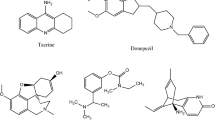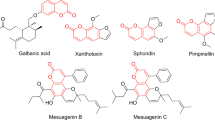Abstract
Alzheimer’s disease (AD), also called senile dementia is a neurodegenerative disease seen commonly in the elderly and is characterised by the formation of β-amyloid plaques and neurofibrillary tangles (NFT). Though a complete understanding of the disease is lacking, recent studies showed the role of the enzyme acetylcholinesterase (AChE) in pathogenesis. Finding new lead compounds from natural sources has always been a quest for researchers. Endophytic fungi are a set of microbes that reside within plants without causing any harm. This study focuses on screening endophytes for the production of active acetylcholinesterase inhibitors. Five endophytic fungi were isolated from Catharanthus roseus and screened for AChE inhibitory activity. Three isolates were found to inhibit AChE inhibitory activity and were distinguished based on molecular and microscopic methods. The mycelial extract was taken for the bioassay-guided column chromatography and TLC was performed on the active fraction. The GC–MS and NMR analysis identified the active compounds in the extract as 9-hexadecen-1-ol and erucamide. Molecular docking studies revealed that the compounds are thermodynamically feasible and have significant glide scores. Computational studies revealed that the hydroxyl group of 9-hexadecen-1-ol forms a hydrogen bond with Ser 293 in the active site of AChE, whereas the active site interactions were predominantly hydrophobic in the case of erucamide and are reflected in AChE inhibition assays.







Similar content being viewed by others
References
Abdel-Azeem AM, Abdel-Azeem MA, Khalil WF (2019) Endophytic fungi as a new source of antirheumatoid metabolites. In: Bioactive food as dietary interventions for arthritis and related inflammatory diseases. Elsevier, 355–384
Ayyolath A, Kallingal A, ThachanKundil V, Variyar EJ (2020) Studies on the bioactive properties of Penicillium mallochi ARA-1 pigment isolated from coffee plantation. Biocatal Agric Biotechnol 30:101841. https://doi.org/10.1016/j.bcab.2020.101841
Benjamin CR (1955) Ascocarps of aspergillus and penicillium. Mycologia 47:669–687. https://doi.org/10.2307/3755578
Čolović MB, Krstić DZ, Lazarević-Pašti TD et al (2013) Acetylcholinesterase inhibitors: pharmacology and toxicology. Curr Neuropharmacol 11:315–335. https://doi.org/10.2174/1570159X11311030006
Daina A, Michielin O, Zoete V (2017) SwissADME: a free web tool to evaluate pharmacokinetics, drug-likeness and medicinal chemistry friendliness of small molecules. Sci Rep 7:42717. https://doi.org/10.1038/srep42717
Ellman GL, Courtney KD, Andres V, Featherstone RM (1961) A new and rapid colorimetric determination of acetylcholinesterase activity. Biochem Pharmacol 7:88–95. https://doi.org/10.1016/0006-2952(61)90145-9
Ferreira-Vieira TH, Guimaraes IM, Silva FR, Ribeiro FM (2016) Alzheimer’s disease: targeting the cholinergic system. Curr Neuropharmacol 14:101–115. https://doi.org/10.2174/1570159X13666150716165726
Gouda S, Das G, Sen SK et al (2016) Endophytes: a treasure house of bioactive compounds of medicinal importance. Front Microbiol. https://doi.org/10.3389/fmicb.2016.01538
Hall BG (2013) Building phylogenetic trees from molecular data with MEGA. Mol Biol Evol 30:1229–1235. https://doi.org/10.1093/molbev/mst012
Hornick A, Lieb A, Vo NP et al (2011) The coumarin scopoletin potentiates acetylcholine release from synaptosomes, amplifies hippocampal long-term potentiation and ameliorates anticholinergic- and age-impaired memory. Neuroscience 197:280–292. https://doi.org/10.1016/j.neuroscience.2011.09.006
Joseph TM, Mahapatra DK (2018) 5-Lipoxygenase and phospholipase A2 inhibitory potentials of alcoholic extract of Cyperus rotundus: in vitro and in silico study. Res Rev J Pharmacol 8:1–5
Kumar S, Stecher G, Li M et al (2018) MEGA X: molecular evolutionary genetics analysis across computing platforms. Mol Biol Evol 35:1547–1549. https://doi.org/10.1093/molbev/msy096
Lima MTNS, dos Santos LB, Bastos RW et al (2018) Antimicrobial activity and acetylcholinesterase inhibition by extracts from chromatin modulated fungi. Braz J Microbiol 49:169–176. https://doi.org/10.1016/j.bjm.2017.06.004
Mazzoli R, Riedel K, Pessione E (2017) Editorial: bioactive compounds from microbes. Front Microbiol. https://doi.org/10.3389/fmicb.2017.00392
Mehta M, Adem A, Sabbagh M (2012) New acetylcholinesterase inhibitors for Alzheimer’s disease. Int J Alzheimers Dis. https://doi.org/10.1155/2012/728983
Murphy MP, LeVine H (2010) Alzheimer’s disease and the β-Amyloid peptide. J Alzheimers Dis JAD 19:311. https://doi.org/10.3233/JAD-2010-1221
Parasuraman S, Raveendran R, Vijayakumar B et al (2012) Molecular docking and ex vivo pharmacological evaluation of constituents of the leaves of Cleistanthus collinus (Roxb.) (Euphorbiaceae). Indian J Pharmacol 44:197–203. https://doi.org/10.4103/0253-7613.93848
Park M-S, Dessal AL, Smrcka AV, Stern HA (2009) Evaluating docking methods for prediction of binding affinities of small molecules to the G Protein βγ subunits. J Chem Inf Model 49:437–443
Pires APC, Oliveira MC, Braga KM et al (2015) Estudo sobre a sensibilidade dos caprinos à toxidez de crotalárias tóxicas para bovinos visando a sua utilização na profilaxia. Pesqui Veterinária Bras 35:501–512. https://doi.org/10.1590/S0100-736X2015000600003
Saitou N, Nei M (1987) The neighbor-joining method: a new method for reconstructing phylogenetic trees. Mol Biol Evol 4:406–425. https://doi.org/10.1093/oxfordjournals.molbev.a040454
Sastry GM, Adzhigirey M, Day T et al (2013) Protein and ligand preparation: parameters, protocols, and influence on virtual screening enrichments. J Comput Aided Mol Des 27:221–234. https://doi.org/10.1007/s10822-013-9644-8
Scholz E, Rimpler H (1989) Proanthocyanidins from Krameria triandra root. Planta Med 55:379–384. https://doi.org/10.1055/s-2006-962032
Seigler DS (1998) Flavonoids. In: Seigler DS (ed) Plant secondary metabolism. Springer, US, Boston, MA, pp 151–192
Selkoe DJ, Peter J Lansbury J (1999) Alzheimer’s disease is the most common neurodegenerative disorder. In Basic Neurochemistry: Molecular, Cellular and Medical Aspects, 6th Ed
Singh JS, Kumar A, Rai AN, Singh DP (2016) Cyanobacteria: a precious bio-resource in agriculture, ecosystem, and environmental sustainability. Front Microbiol. https://doi.org/10.3389/fmicb.2016.00529
Taylor P, Camp S, Radić Z (2009) Acetylcholinesterase. In: Squire LR (ed) Encyclopedia of neuroscience. Academic Press, Oxford, pp 5–7
Tripathi SK, Muttineni R, Singh SK (2013) Extra precision docking, free energy calculation and molecular dynamics simulation studies of CDK2 inhibitors. J Theor Biol 334:87–100. https://doi.org/10.1016/j.jtbi.2013.05.014
Wang Z, Ma Z, Wang L et al (2015) Active anti-acetylcholinesterase component of secondary metabolites produced by the endophytic fungi of Huperzia serrata. Electron J Biotechnol 18:399–405. https://doi.org/10.1016/j.ejbt.2015.08.005
Yashavantha Rao HC, Santosh P, Rakshith D, Satish S (2015) Molecular characterisation of an endophytic Phomopsisliquidambaris CBR-15 from Cryptolepis buchanani Roem and impact of culture media on biosynthesis of antimicrobial metabolites. 3 Biotech 5:165–173. https://doi.org/10.1007/s13205-014-0204-2
Zhu X, Raina AK, Perry G, Smith MA (2004) Alzheimer’s disease: the two-hit hypothesis. Lancet Neurol 3:219–226. https://doi.org/10.1016/S1474-4422(04)00707-0
Acknowledgements
The authors express their sincere gratitude to the faculties at the Department of Biotechnology and Microbiology, Dr. Janaki Ammal campus, Kannur University, for their support rendered during the study.
Funding
This research received no specific grant from public, commercial, or not-for-profit funding agencies.
Author information
Authors and Affiliations
Contributions
A.K, V.T.K and A.A :Conceptualization, Writing original draft, Methodology, Formal analysis. T.M.J, A.M.S, J.TH and S.T: review & editing. A.A: Supervision, review & editing
Corresponding author
Ethics declarations
Conflict of interest
The authors declare that they have no conflicts of interest.
Additional information
Communicated by Erko Stackebrandt.
Publisher's Note
Springer Nature remains neutral with regard to jurisdictional claims in published maps and institutional affiliations.
Rights and permissions
Springer Nature or its licensor (e.g. a society or other partner) holds exclusive rights to this article under a publishing agreement with the author(s) or other rightsholder(s); author self-archiving of the accepted manuscript version of this article is solely governed by the terms of such publishing agreement and applicable law.
About this article
Cite this article
Kallingal, A., Ayyolath, A., Thachan Kundil, V. et al. Divulging the anti-acetylcholinesterase activity of Colletotrichum lentis strain KU1 extract as sustainable AChE active site inhibitors. Arch Microbiol 204, 713 (2022). https://doi.org/10.1007/s00203-022-03288-9
Received:
Revised:
Accepted:
Published:
DOI: https://doi.org/10.1007/s00203-022-03288-9




